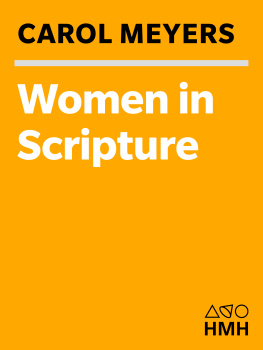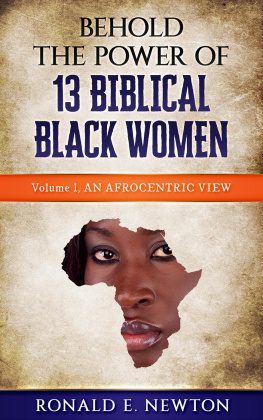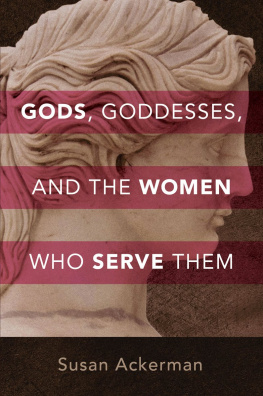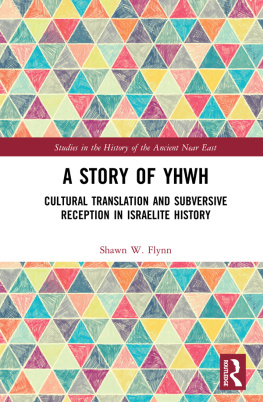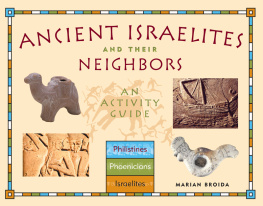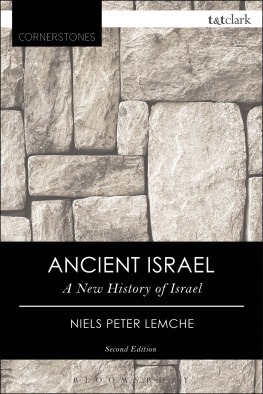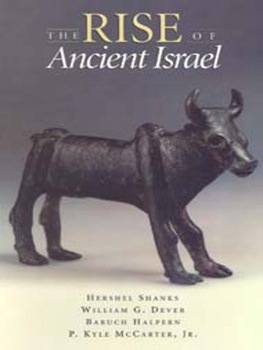Rediscovering Eve
Rediscovering Eve
Ancient Israelite Women in Context
CAROL MEYERS


Oxford University Press is a department of the University of Oxford. It furthers the Universitys objective
of excellence in research, scholarship, and education by publishing worldwide.
Oxford New York
Auckland Cape Town Dar es Salaam Hong Kong Karachi
Kuala Lumpur Madrid Melbourne Mexico City Nairobi
New Delhi Shanghai Taipei Toronto
With offices in
Argentina Austria Brazil Chile Czech Republic France Greece
Guatemala Hungary Italy Japan Poland Portugal Singapore
South Korea Switzerland Thailand Turkey Ukraine Vietnam
Oxford is a registered trademark of Oxford University Press
in the UK and certain other countries.
Published in the United States of America by
Oxford University Press
198 Madison Avenue, New York, NY 10016
Oxford University Press 2013
All rights reserved. No part of this publication may be reproduced, stored in a
retrieval system, or transmitted, in any form or by any means, without the prior
permission in writing of Oxford University Press, or as expressly permitted by law,
by license, or under terms agreed with the appropriate reproduction rights organization.
Inquiries concerning reproduction outside the scope of the above should be sent to the
Rights Department, Oxford University Press, at the address above.
You must not circulate this work in any other form
and you must impose this same condition on any acquirer.
Library of Congress Cataloging-in-Publication Data
Meyers, Carol L.
Rediscovering Eve : ancient Israelite women in context / Carol Meyers.
p. cm.
This work was published in 1988 under Discovering Eve : ancient Israelite women in context.
Includes bibliographical references and index.
ISBN 9780199734559 (hardcover : alk. paper)ISBN 9780199734627 (pbk. : alk. paper)
1. Jewish womenPalestineHistory. 2. Women in Judaism. 3. Women in the Bible.
4. PalestineSocial life and customsTo 70 A.D. I. Title.
HQ1172.M49 2013
305.4862dc23
2012008782
ISBN: 9780199734559
9 8 7 6 5 4 3 2 1
Printed in the United States of America
on acid-free paper
For Eric
Contents
Preface
MORE THAN TWENTY years ago, with the encouragement of many colleagues and friends, I published a bookDiscovering Eve: Ancient Israelite Women in Context (Oxford, 1988)that I hoped would enlighten readers about women in the biblical past. My goal was twofold: to provide new ways of understanding the Eve of the Genesis narrative, and also to reconstruct the everyday lives of women in the earliest period of ancient Israelite existence. The second goal would presumably contribute to the first. The book drew on biblical texts, archaeological data, and social science materials.
Much has changed since the 1980s in all of the areas that were my resources for that book, and I was thrilled when Oxford seemed interested in publishing a revised version that would take into account those changes along with my own subsequent work on women in the world of the Hebrew Bible. Having agreed to update the 1988 book, I soon found that a revision was not possible. I would not be merely correcting or improving or updating a few points; I would not simply be adding some references. The changes I found myself making were too extensive and too profound for the result to be considered a second revised edition. At every step of the way, I found myself able to retain very little of the previous book. It is my hope that the new title, Rediscovering Eve: Ancient Israelite Women in Context, acknowledges my indebtedness to its antecedent but also represents the fact that there are substantial differences. The present book is similar in structure and goals to its predecessor but also differs in many ways.
Most obvious is the scope. Readers who are familiar with the 1988 book will notice that I no longer restrict my observations about womens lives to the earliest period of ancient Israel (Iron Age I, ca. 12001000 BCE). Rather, I believe that the agrarian life that obtained in that period continued throughout most of the Iron Age for most people.
Also, the ensuing decades of anthropological and archaeological research, at least some of which has been directed to understanding households, have provided a sounder basis for reconstructing the context of womens lives. I believe that this research has enabled me to draw a richer portrait of their daily experiences than before. Similarly, when I began my work on biblical and Israelite women in the 1980s, the literature on the subject was rather limited. Now it is enormous, as is the general literature in the study of sex and gender by anthropologists, literary critics, and others. The possibilities for interpreting gender relations as well as for understanding Israelite society have expanded, and this book has been the beneficiary. Before, I struggled to find worthwhile scholarly resources; here I struggled to judiciously represent or incorporate scholarly trends without overwhelming the reader with references to every pertinent study.
Finally, my views have changed or been refined, not only by all the literature I have consulted but also because of the many more opportunities I have had to teach, lecture, and write, in academic settings and in the wider community, about various topics relevant to this project. Over the years the questions and comments of students, teaching assistants, colleagues, editors, and the many other people who have heard me talk about Eve and Israelite women have challenged, supplemented, and otherwise altered my views. I also took seriously the published reviews of the predecessor booksometimes agreeing with a reviewers criticism and revising my exposition, and sometimes sharpening (I hope) my arguments.
My gratitude to the people who provided direct assistance as I researched and wrote this book is enormous. The librarians at Duke University were unfailingly cooperative in helping me obtain the materials I needed. Colleagues at other institutions were graciously willing to provide advance copies of work not yet published. The staff in the Religion Department at Duke cheerfully assisted me in technical matters. A Duke graduate student, Sean Burrus, enthusiastically helped me with proofreading and reference checking; he also offered many astute observations about the content, enabling me to improve the manuscript. As for Oxford University Press, a deep expression of thanks goes to Cynthia Read, who took on my 1988 book and was willing to let me try again in 2011. Her assistant, Lisbeth Redfield, graciously provided answers to my many questions about manuscript submission. The copyeditor, Gary Berleth, improved the manuscript in countless ways. Finally, the production manager, Sravanthi Sridharan, patiently responded to my many queries as she expertly moved the manuscript through to production. To all these people I am extremely grateful.
Finally, I could hardly have completed this project without the deep interest, loving support, professional encouragement, and scholarly advice of my husband, Eric. Moreover, his patience has been nothing short of phenomenal, considering how often I spent evening and weekend hours working on this book instead of enjoying time together with him.
Carol Meyers
Duke University
Durham, North Carolina
December, 2011
Next page

